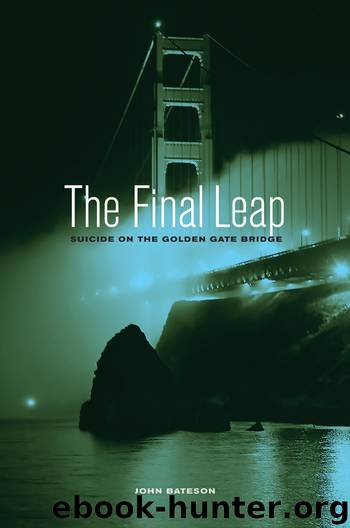The Final Leap by John Bateson

Author:John Bateson
Language: eng
Format: epub
ISBN: 9780520951402
Publisher: University of California Press
The common belief among the general public is that when someone picks up one of the thirteen specially-marked crisis phones on the Golden Gate Bridge, he or she is connected immediately to a suicide prevention counselor, most likely at San Francisco Suicide Prevention. Even some Bridge District officials believe this. In minutes from the district’s January 27, 2005, meeting, board member Janet Reilly, a bridge barrier supporter, asked how many times the crisis telephones on the bridge are used. Kary Witt, the bridge’s general manager, replied that four to five calls are made per year by suicidal individuals, and that the calls are routed to San Francisco Suicide Prevention. He was mistaken. In fact, Meyer says that her agency hasn’t received a single bridge call since 1994. That’s the year that calls started being answered by a police dispatcher—if they’re answered at all. There are numerous photos on the Internet of “Out of Order” signs on Golden Gate Bridge phones. Salt air corrodes phone lines, and replacing them is costly and time consuming. People pose next to the phones for photographs, and sometimes pick up the receiver pretending to be suicidal, but they’re seeking a memento, something to remember a walk on the world’s deadliest span, rather than help.
Dr. Paul Linde is a psychiatrist in the emergency room at San Francisco General Hospital, where many potential Golden Gate Bridge jumpers are taken by police. He starts his book, Danger to Self, by saying, “I love my job when I’m not there.” He explains that while the work is intellectually and emotionally demanding, when he’s not there he has “a decent shot at separating out my job’s trauma and drama from the rest of my life. But in my workplace, there’s no place to hide.” It’s another way of saying that dealing with people who have persistent, severe, and complex mental illnesses—illnesses that often lead them to attempt suicide—is analogous to the intense theatrics of opera. The only thing that’s missing is the music.
One important aspect to explore is the ambivalence that’s behind every expression of suicidal intent. After all, it’s unlikely that persons who are 100 percent committed to die will call a hotline or disclose much information to a psychiatrist. Often, they don’t want to be talked out of it, nor do they want anyone to interfere. They just act.
Dr. David Jobes is a clinical psychologist who has treated hundreds of suicidal patients, written books on suicide prevention, and lectured around the country on the subject. One question he suggests that all mental health professionals ask of anyone who’s suicidal is, “When you think of suicide, does it scare you or comfort you?” As hard as is it for most people to believe, the thought of suicide is comforting to individuals who are trapped in their own version of hell. It’s a coping strategy to employ if their pain becomes too great. The suicidal person’s perception of the world is so narrowed by his or her suffering that nothing else matters.
Download
This site does not store any files on its server. We only index and link to content provided by other sites. Please contact the content providers to delete copyright contents if any and email us, we'll remove relevant links or contents immediately.
They Both Die at the End by Adam Silvera(9480)
Thirteen Reasons Why by Jay Asher(8451)
The Space Between by Michelle L. Teichman(6573)
Suicide Notes by Michael Thomas Ford(4648)
Tuesdays with Morrie by Mitch Albom(4394)
Suicide: A Study in Sociology by Emile Durkheim(2903)
The Checklist Manifesto by Atul Gawande(2657)
Tuesdays With Morrie by Mitch Albom(2572)
In the Woods by Tana French(2408)
Bossypants by Tina Fey(2373)
Robin by Dave Itzkoff(2268)
Olive Kitteridge by Elizabeth Strout(2206)
No Ashes in the Fire by Darnell L Moore(2206)
Reservoir 13 by Jon McGregor(2142)
End of Days by Sylvia Browne(2050)
All Things New by John Eldredge(2048)
Bus on Jaffa Road by Mike Kelly(2034)
Scar Tissue by Anthony Kiedis(2008)
No Time to Say Goodbye(1997)
